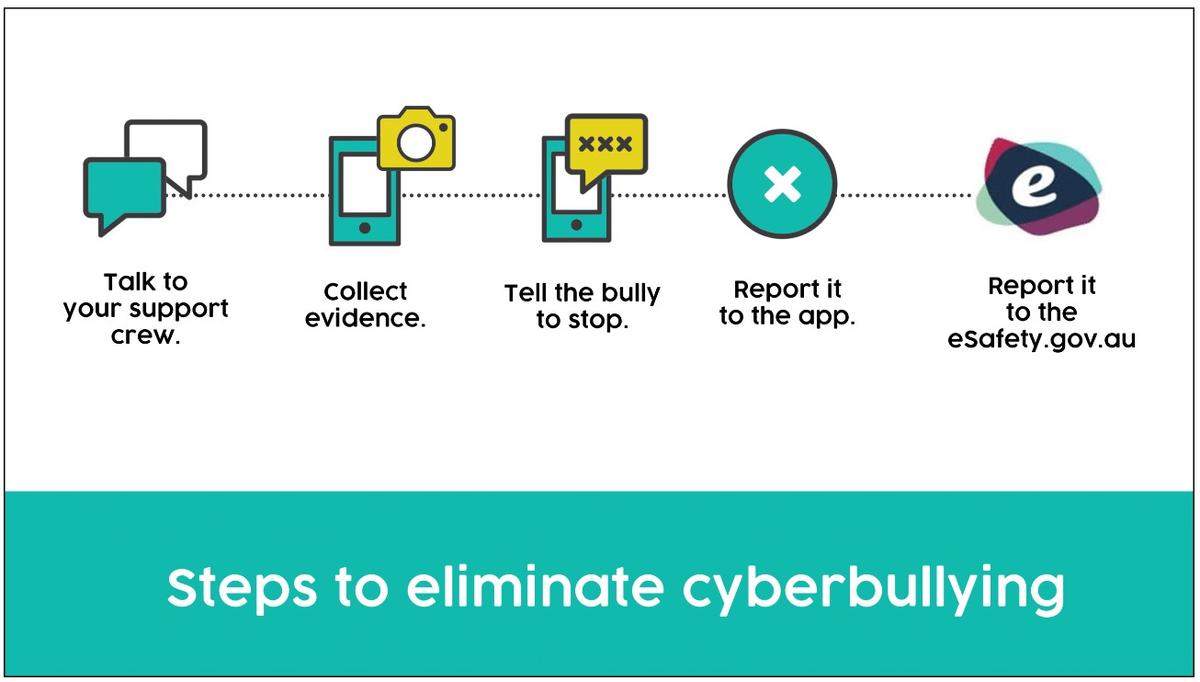Cyber Safety
Keeping our families safe online...

Cyber Safety
Keeping our families safe online...
Written by The Cyber Safety Project


I think my child may be experiencing bullying online, what can I do?
If you are concerned that your child may be experiencing online bullying here are some suggested intervention strategies:
1. Start by talking
While getting all the details may seem like a good idea, your child may not feel entirely comfortable disclosing everything to you. In fact, your questions may feel like an interrogation. Instead, start by talking about your own online experiences, weaving in the good and the bad. It may seem strange or ‘out of the blue’ to hear you talking about technology in this way, so the earlier these conversations begin in your household, the more normalised conversations about this topic will become. It’s also a good idea to regularly remind your children that ‘There is nothing you could ever do that I wouldn’t forgive’, ‘We all make mistakes and I am here to help you make things right’, and ‘No matter what happens, I am always here to help’. Looking for some conversation starter ideas around this topic? We’ve put together a list for you here.
2. Discuss help seeking strategies
Whilst we would all hope our children come to us as the first point of call, for many children the thought of telling a parent is ‘out of the question’ for fear of technology being banned or getting into trouble. Help your child identify three trusted adults (other than you) in their life that they could turn to for help when things are going wrong or they aren’t sure what to do. This may be a grandparent, sibling, cousin, aunt or uncle, or a teacher at school. Also ensure your children know how to access the Kids Help Line.
3. Document and report misconduct
Should you find material online that you believe is inappropriate conduct and involves your child, take a screenshot of the activity as evidence. There are laws about cyber bullying that you and your children should be aware of. Resist the urge to close down accounts or respond yourself. When reporting serious cases of bullying, the police will require access to social media accounts as well as evidence. If you aren’t sure if you should report cyber bullying, check out this resource from the eSafety Commissioner.
Social Networking applications are taking greater responsibility for cyber bullying and inappropriate content appearing on their platforms. Most Social Networking applications have a reporting system in place aimed at flagging inappropriate content and abusive behaviour. Talk about these features and ensure your children know how to use them and the fact that when using these features they remain anonymous.
4. Limit online access
If you start to see behavioural shifts around the time your child is using connected technology (such as anger, anxiety or signs of depression) you may want to limit their access. Set clear rules and expectations that promote appropriate screen time use, including help seeking strategies when problems or uncomfortable situations arise. Our Family Digital Use Guidelines are a perfect starting point for setting technology use expectations for the whole family. Many applications have great parental controls that can be helpful in monitoring your child’s digital use, including the use of screen time analytics through Apple Family Sharing or Google Family Link.
5. Foster positive online protocols
One of the best ways to prevent cyber bullying is to make sure your children clearly understand what cyber bullying is and how to identify it. They must know that bullying is not tolerated in either offline or online spaces. Make sure they understand that they too must respect others online, reducing the likelihood of them becoming a target when they are conducting kind, friendly and respectful dialogue themselves. Another important step is to ensure your children make use of Privacy Settings within their apps or accounts. There are often settings that allow you to block specific users or turning on features such as ‘hide offensive comments‘.
6. Promote kindness and positivity in these spaces
Online communities, whether that be within online games or social networks, are regulated by those who participate: your children. They are the creators of their online communities and set the tone for the environments in which they engage. Through gaming and social media we are regularly hearing of toxic, inappropriate and harmful dialogue. It’s important that young people are calling out, blocking and reporting behaviour that they don’t feel aligns with their own values or the terms and conditions set out by the digital platform. Help your child to promote and encourage kind behaviour towards their friends and make healthy choices when it comes to who they choose to engage with in online spaces.
7. Get your child actively engaged offline
Help your child discover and establish positive friendships in offline settings such as engaging with sports, hobbies or extra curricular activities. Through a child’s formative years, these face to face relationships offer positive offline experiences for children and allow for the development of authentic and life long friendships to flourish. Having offline friends can create an important support network and provide your children with someone to turn to when things go wrong for them online.
*Help seeking resources:
Kids Helpline: Kids Helpline | Phone Counselling Service | 1800 55 1800
eSafety: Online safety | eSafety Commissioner
Family Resources: Families – Cyber Safety Project